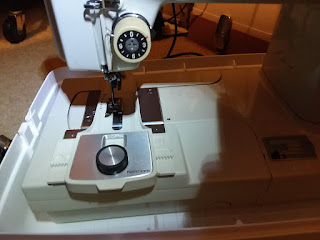SEARS Kenmore 158.19310 Sewing Machine
Stitch selector function video
12 built in stitches
straight stitch
Left homing needle
CAMS type C Kenmore cams. 45 different stitch cams are available
Q foot & stretch needles for sewing KNITS without skipped stitches
Super High Shank Kenmore quick change presser foot system, a simple lever (requires no tools)
Freearm for easier sewing in the round, with bed extension for flatbed sewing ease
Auto release bobbin winder
Pull out handwheel bobbin winding clutch release, push in to sew
Calibrated tension dial
Twin needle capable
Dual belt system, 1.2 or 1.0 Amp motor (Apparently many model 1931 only had 1.0 amp motors, so I am updating this.) concealed in base of machine
Kenmore model 1931 freearm makes it easy to sew cuffs, necklines, and armholes, easily, which makes it simpler to sew in the round, with even seams. Calibrated stitch widths are engraved into the needleplate, with a convenient thumb screw hole for a seam guide, or any folders or binder attachments you choose to use with your Kenmore, can make perfect seams easier to accomplish. There is both a front and back snap on bed piece, and a single piece of aluminum which forms the underbed for these, to turn your freearm machine into a flatbed machine, for ease in sewing larger projects. The entire machine is portable, but can be attached to a sewing table, if desired, the front removable bed piece, makes access to the bobbin door convenient for changing bobbins.
MODEL 1931
12 built in stitches
straight stitch
Stretch straight stitch
zigzag stitch
zigzag stitch
Rickrack stretch zigzag stitch)
blind hem
multistitch zigzag
overlock stitch
smocking stitch
box stitch
Turkish Hem
reverse blind hem stitch
blanket stitch
blind hem
multistitch zigzag
overlock stitch
smocking stitch
box stitch
Turkish Hem
reverse blind hem stitch
blanket stitch
 |
CAMS type C Kenmore cams. 45 different stitch cams are available
REQUIRES CAM 20 TO SEW BUILT IN STRETCH STITCHES! Also flip stitch modifier lever to stretch it looks like an exclamation point! Top is longer setting, point is shorter reverse stitches.
Q foot & stretch needles for sewing KNITS without skipped stitches
Super High Shank Kenmore quick change presser foot system, a simple lever (requires no tools)
Freearm for easier sewing in the round, with bed extension for flatbed sewing ease
Straight stitch needleplate is separate from zigzag plate Interchangeable snap in (no tools needed)
Calibrated needleplate, to left and right of needle
Auto release bobbin winder
Pull out handwheel bobbin winding clutch release, push in to sew
Calibrated tension dial
Twin needle capable
Dual belt system, 1.2 or 1.0 Amp motor (Apparently many model 1931 only had 1.0 amp motors, so I am updating this.) concealed in base of machine
Freearm bed extension with geared plate to use flat BUTTONHOLER
 |
 |
| Satin stitch overedge presser foot |
 |
| Zigzagging over overedge foot |
 |
| 158.19310 accessories |
158.19311 accessory set
CHAINSTITCH
1931 freearm, DID NOT have chainstitch capability (1913 DID), so your bobbin hook does not have the tiny hole for the adapter propeller/hook, but if you have a Kenmore machine with the hole in the hook, you can trade them out.
If you use the bobbin HOOK with the extra hole (borrowed from a luxury flatbed model), for the chainstitch adapter bobbin insert propeller to lock into, you can make your 1931 chainstitch capable.
Chainstitch adapters can be hard to find, they came in the little yellow plastic box with clear cover, a silver bobbin insert propeller, and a dark brown, or black needleplate insert. The bobbin inserts are interchangeable, but the needleplates are not. If you can't find the needleplate for your model, some people take a regular needleplate, and modify it, for chainstitch.
(I haven't seen a Kenmore monogrammer for this model, that I recall, currently)
I don't have the manual, just the machine, at the moment
(I haven't seen a Kenmore monogrammer for this model, that I recall, currently)
I don't have the manual, just the machine, at the moment
An interesting blog about chainstitching with Kenmore 158.xxxx (Maruzen Jaguar) models, can be found here, with excellent illustrations and explanations on how the chainstitch forms, as well as how the other gentleman blogger actually adapted other class 15 sewing machines to accept the Kenmore chainstitch adapters, to sew a chainstitch.
https://vintagesewingmachinesblog.wordpress.com/2017/09/19/reliable-chain-stitch-with-the-jaguar-adapter/
1931 stretch stitch mechanism needscleaned and oiled to free it up.https://vintagesewingmachinesblog.wordpress.com/2017/09/19/reliable-chain-stitch-with-the-jaguar-adapter/
Set stitch length at longest setting.
Dip paintbrush or toothbrus in rubbing alcohol or kerosene, and scrub both sides of reverve pivoting cam follower.
Oil both sides of pivoting cam follower
Work reverse lever repeatedly, to work oil in, until pivoting cam follower allows instant rebound of the pivoting cam follower, when you release reverse lever.




















